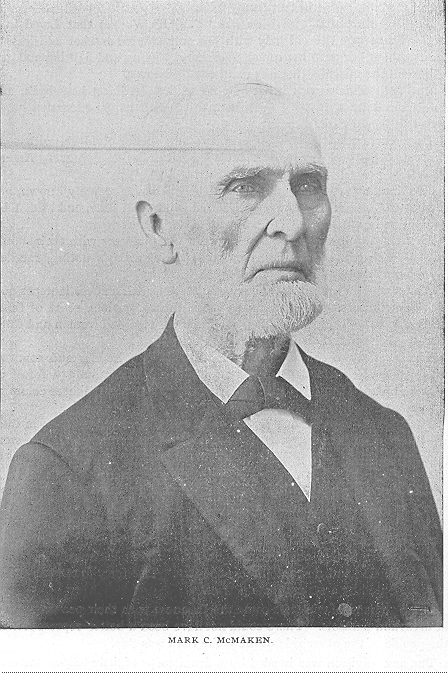
THE CENTENNIAL ANIVERSARY OF HAMILTON, O.- 51
Then came the little queens, some hauled in wagons. some walking under canopies carried by obedient servants.
Then there was the butterfly queen surrounded by a body guard of butterflies with their wings spread, ready to waft their flight to the upper world. This was one of the most beautiful sights in the whole procession and elicited praise from everyone.
The dwarfs and their queen came in for praise as did the shepherds and shepherdesses, with their peculiar dress and long bended crooks.
Another May-pole was surrounded by a happy band of girls and was followed by another queen with her youthful subjects. She was escorted by a guard of brave little soldiers who, in their imagination, could whip the world.
The school children, some in red, some in white and some in blue, followed, waving their flags and shouting for America and her banner of freedom.
The first float in the last division was a beautiful queen with innumerable attendants which was followed by another queen with her subjects kneeling at her feet in humble devotion to her majesty.
One of the best representations in this division was that of a half watermelon, on wheels and filled with little girls.
Another May-pole was added to the festivities, followed by groups of school children of all sizes and ages.
The procession closed with a grand representation of the travels of that old fellow so dear to every youthful heart and for whom every child will soon be looking--Santa Claus. With his reindeer drawing a sleigh filled with good things, he made many a little one's eyes gleam with delight.
After the procession had all passed the reviewing stand and Hamilton battalion had cleared the street, a May-pole dance was given in front of the court house. After the grand march the pole was wound with great ceremonies and when the ends of the ribbons were reached and the last one platted about the pole, the end of the first day's celebration of our centennial was reached.
The “Feast of Flowers and Youth" far surpassed the fondest anticipations of every one. It was grand and words cannot describe it. Every little fellow held in his hand an Ameaican flag and patriotism is the only thing that that nights festivities could have taught. About this feast will cling many of the fondest recollections of our Centennial in the hearts of those who participated in it.
It was for the youth and truly the youth enjoyed it. Nothing like it was ever seen before in Ohio, and another hundred years must pass away before such a sight can again be seen on the streets of Hamilton.
The program for Friday evening was carried out to the letter and was one of the greatest successes of the celebration. For weeks previously, the different wards were busily engaged in preparation, and a pleasant rivalry arose between them as to which should be esteemed the greatest. It was

THE CENTENNIAL ANNIVERSARY OF HAMILTON, O. - 53
expected therefore, that many beautiful, entertaining and instructive features would he the result and the public was not disappointed. These different ward celebrations took place in the public halls and parks of the city. But a mere reference to each can be made here, as a complete description would require a volume. They consisted of musical and dramatic exhibitions recitations, addresses and comical presentations of various kinds.
The First Ward program was instructive, entertaining and amusing.
The following was the program rendered : "Overture, Orchestra, Rag Baby ; Ball, twenty young misses danced to the air, "Down went McGinty ;'' Recitation, Miss Josephine Slater; Maypole Dance twenty young ladies, led by Miss Kate Kennedy ; Vocal solo, Miss Maud Miller; Recitation Miss Pearl Murphy ; Selection, orchestra; Spinning and Husking Bee, ten young ladies and ten gentlemen ; "Piano Solo," Sidney Durst ; Vocal Solo, Miss Kate Kennedy; Selection, orchestra ; The First Ward Minstrels gave one of their inimitable performances which brought down the house, and Mrs. Margedant concluded the program by reading a poem written by W. S. Warwick, of the First ward, especially for this occasion, The music furnished was from Middletown and deserved special notice for the pieces selected and rendered.
The hall was beautifully decorated with festooning, graceful plants, and everywhere was seen the glorious red, white and blue.
As an opening, Mayer's orchestra gave a concert. Dr. Dan Millikin was the speaker of the evening. In his own inimitable style he delivered an address full of patriotism, interspersed with many laughable stories and those of a different nature, about which lie wove lessons of love, duty, honor and devotion to liberty and mother country. T. e whole was a fine effort.
Following this a quartette sang, "The Sea has Its Perils." Henry Wilmer sang a tenor solo, Miss Tillie Brinker and John Stephan sang a duet, and Miss Bertha Sheehan, one of Second ward's leading belles, added to the festivities of the evening by rendering a solo in her most approved style.
The last number of the first part of the program was a solo by Henry Brinker.
The second part of the program was commenced by another rendition by the quartette. "Sweet and Low'' was sung. Three solos followed, the first by Miss Tillie Brinker, the second by Henry Brinker and the last by Miss Ada Fye. All were good. The closing number was a duet by Henry
Brinker and daughter. Miss Tillie.
Second ward may well be proud of its celebration, because it was one of the best in the city.
The residents of the Third Ward held an informal reception at Beckett's hall. The Martha Washington Zuaves entertained those present with an exhibition drill which was fine. The company was in command of Captain Jennie Holiday who was warmly praised for her cool manner in drilling the company. At 8:30 o'clock the young ladies left the hall and marched down
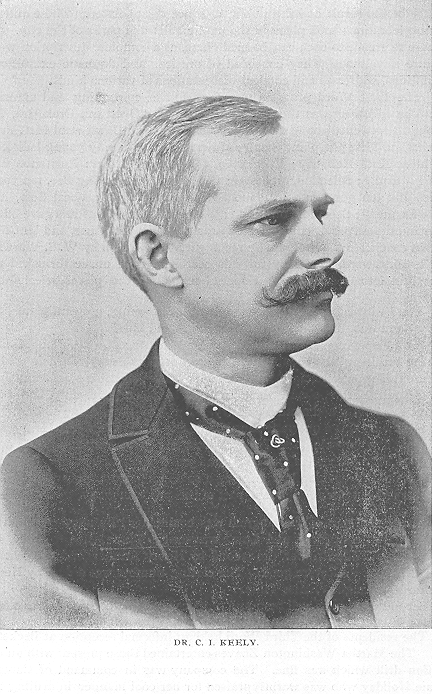
THE CENTENNIAL, ANNIVERSARY OF HAMILTON, O. - 55
on High street, where they gave a fine exhibition of their drilling before a large crowd of spectators
In Ludlow Park the residents of the Fourth ward clearly demonstrated that they are possessed with a genuine spirit of patriotism. The promenade concert which took place in beautiful Ludlow park was a glorious success and those who had the project in charge deserve the highest praise. It is but just to state that Mrs. Josephine Weiler is entitled to no small share of the credit in making the promenade concert a brilliant and memorable success. It was through her indefatigable and unceasing efforts that the Fourth ward that pre-eminently stood out as the ward having attempted a great undertaking and likewise was grandly successful in carrying out the project to a brilliant ending. To describe the illumination and in any way do it justice would be utterly beyond the meager descriptive powers of the writer. To say that the park was hterally ablaze with countless lights would not in the least be extravagant nor an exaggeration of facts. Great lines of lanterns of unique and pretty design, hung profusely and dazzlingly from the sturdy oak to the delicately lighted glass globes below. The overpowering volume of light and dancing colors formed a most beautiful spectacle.
It was 7:30 before the Apollo band arrived, and after they favored the vast audience with some charming music, M. O. Burns, master of ceremonies, introduced Mayor harsh.
In a few well chosen remarks the mayor introduced Governor Campbell to the assemblage.
The governor, of course, devoted himself wholly to the early history of the city. His remarks were listened to with marked attention. Hon. J. J. McMaken and John F. Neilan also made brief historical speeches, referring to the Indians, the wild turkeys and the desolate forests of a hundred years .ago which surrounded Fort Hamilton. At the conclusion of the speech making a triple quartette rendered several sweet songs which were loudly .applauded by the enthusiastic crowd. The Maypole dance which concluded the evening's festivities was very pretty. To the sweet strains of music the picturesquely attired and attractive little maidens gracefully plaited about the pole the nation's colors, red, white and blue, and then in reverse motion unwound it much to the delight of the crowd.
The Fifth ward had no special program but participated in the great centennial meeting at the Court House, to which all the other meetings adjourned upon the conclusion of their own programs.
The meeting at the Court House was grand in size, enthusiasm, eloquence and music.
The musical program was a magnificent production and great credit is due to Professor Mayer and Director Schweinfest for its success. The whole city this evening was one splendid combination of decorations, brilliancy and enthusiasm which was wrought to the highest, by the eloquent and patriotic
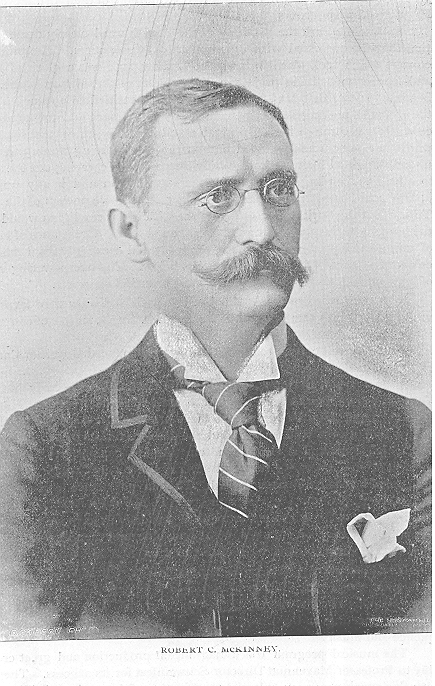
THE CENTENNIAL ANNIVERSARY OF HAMILTON, O. - 57
addresses of the distinguished speakers. Great as was the previous portion of the celebration, it was eclipsed by the monster parade of Saturday. The booming of the cannon in the early morning awoke the echoes, brought the thousands from their homes, prepared to crown the festivities with the greatest display ever witnessed in this country.
The day's proceedings began at the Court House. After invoking the divine blessing Father Varelman, the Chaplain, followed the grand vocal concert, in which five hundred trained voices participated, accompanied by an orchestra of one hundred pieces.
Professor Mayer had spent weeks in preparation for this great musical event and the result was worthy of his efforts. It was one of the greatest musical successes ever witnessed in this part of the country, and for this Prof. Mayer and all who participated, are entitled to great praise.
The singing of the great National Anthem, "My Country" participated in by the school children under the leadership of Prof. Gottschalk and thousands of the audience, with the regular chorus, was one of the most inspiring scenes ever listened to and wrought up the immense multitude to a high pitch of enthusiasm.
The musical program being completed, letters were read from distinguished persons, who were unable to be present, after which followed the addresses.
These addresses will be found in another place in this volume, and need not be referred to here further than to say that they were worthy the occasion and the learning and well-known ability of the gentlemen who made them.
Next came the mammoth parade composed of four grand divisions. No language can describe the great spectacle presented by this vast moving mass, which contained within itself the best evidence, not only of the wonderful progress of the hundred years proceeding, but also of the magnificent manufactories and business enterprises of our city, No such parade was ever before seen in this city and it will doubtless be many years before such another will be manifested.
Promptly at 2 o'clock, with the grand marshal Capt. W. C. Margedant at the lead, the long procession started from the head of Main street, and in turn moved over the line previously designated.
The grand marshal and his staff were as follows
Grand marshal, Capt. W. C. Margedant; Chief of Staff, Thomas Millikin; Adjutant General, F. D. Bristley; Majors, J. F. Neilan, H. L. Morey, L. M. harsh ; Assistant Grand Marshals, Rev. E. W. Abbey, S. I. Beeler, H. C. Gray, Peter Schwab, Rev. F. F. Varelman, Lazard Kahn, Robert Allstatter, Christ Pabst, Jos. H. Long, Thomas V. Howell, Joseph J. Pater, Fred C. Mayer, Dr. W. Z. Kumler, Prof. Alston Ellis, Geo. W. Stace, H. P. Deuscher, Chris Benninghofen. Dan Millikin, Homer Gard, Chas. D. McBeth,
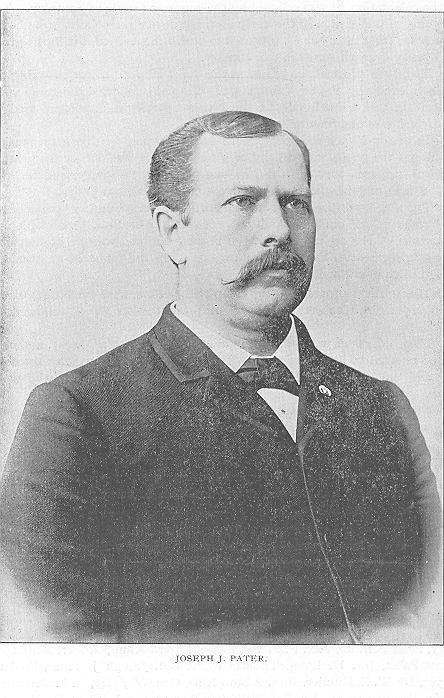
THE CENTENNIAL ANNIVERSARY OF HAMILTON, O. - 59
W. C. Frechtling, W. L. Huber, Albert Dix, J. M. Long, Isaac Rogers, J. M. Downey; aids-de camp, Allen Andrews, Dr. C. I. Keely.
The parade consisted of four grated divisions as follows
FIRST Division—Military. Col. George H. Phillips, grand division commander.
This division consisted of the military and uniformed bodies. Grand division commander and staff, 6th U. S. regular troops preceded by U. S. band, Ohio National guards and cadets, G. A. R. and soldiers of the late war and war with Mexico and uniformed and civic organizations.
SECOND DIVISION--Historical. Capt. Adolph Metzner, grand division commander; Dr. Geo. C. Skinner, chief of staff; Max Reutti, assistant adjutant general; Gustave Steffe, F. W. Soehner, Albert Hossfeld, G. A. Lambert, W. W. Larue, Wm. E. Bender, John Robertson, John C. Rochelle, Chas. Diefenbach, James Tully, Phillip Conboy, I. N. Slayback, W. N. Gray, W. B. Brown, Chas. Solingen, John Doellman, Henry Sohn, C. D. Mathes, assistant division marshals ; A. Schultz, Wm. Ritchie, Sam. D. Fitton, aids-de-camp.
THIRD DIVISION,—Industrial. Col. R. C. McKinney, grand division commander; Col. J. H. Springer, chief of staff; John B. Krocker, adjutant general. This division consisted of tableau wagons and floats, carrying representations of the various kinds of manufactories and other industries of Hamilton.
The Agricultural and Civic division was under Chris Rothenbush, grand -division commander and the following staff; S. T. Harwood, chief of staff; Robert M. Elliott, assistant adjutant general; F. M. Hughes, James Reed, Philip J. Faber, majors; Levi J. Truster, D. L. Tyler, James M. Lewis, James Linn, Nathan C. Flenner, R. M. Billingslea, Robert Long, James M,. Carr, A. Morris, Jos. Billingslea, J. W. Sloneker, J. R. Emrick, Wm. Heerman, P. J. Somers, Thomas J. Hughes, Wm. Allen, Isaac L. Riley, Chas. Fallert, W. H. Jacobs, A. J. Welliver, F. F. Humbach, Wm. Schlosser, Dr. J. J. Roll, John Bender, Jacob Seybold, assistant division marshals ; W. H. Todhunter, Frank Morris, aides-de-camp.
The division was preceded by a band which was followed by the grand division commander and staff. Then came the clergy of the city, and distinguished guests in carriages. Following these were the city and county officers and the municipal boards. After these came citizens generally, township delegations and all bodies not included in the other divisions, and every other person who desired to join in the parade.
Every division was worthy of special mention and presented many features to excite the admiration of the vast multitude that witnessed them.
This was particularly true of the second and third divisions which were from beginning to end wonderful exhibitions of the great ingenuity, and adlistic skill both in their conception and execution. This is particularly true

THE CENTENNIAL ANNIVERSARY OF HAMILTON, O. - 61
of the Historical and Allegorical floats in the second division,
With music at its head, came this division with its allegorical representations of the times which this celebration calls to our minds.
The first grand tableau wagon, or float represented the ABORIGINES surrounding their uncooth home. The buckskin wigwams, with smoke curling from their apex, the black-haired, browned-skinned natives, the medicine man stirring his malarial bitters, the rippling stream of water flowing gently over its bed of gravel—all went to make this a scene of picturesqueness and instructive beauty.
The second tableau represented OLD FORT HAMILTON. This reminded one of former times with its stockade, made of unhewn logs, with the cupola of the old fort towering over its top. Wandering about at their leisure or attending to their military duties were the soldiers dressed in the antiquated uniforms of revolutionary times. Within the stockade could be seen the representation of the old well which is now known as "Sohn's well," on Water street. The whole tableau was permeated with the true spirit of the times as they were one century ago, and, had one of our pioneer settlers been a witness of this representation, he would have gone into ecstasies over its realities.
The third tableau represented THE FIRST PIONEERS, who penetrated the wilderness west of the Alleghanies, braving the inclemencies of the weather, until, amid surrounding forest, they reared a home to be protected. by them against the ravages of the wild beasts and the savage attacks of the red man. The old army pump, as it has been used for centuries previous,. raising its precious burden of pure, sparkling water. The little girl babe playing at its mother's feet, the house dog, brought from a home far away, the father, in all the sturdiness of his manhood, the sons filled with youthful promise, the sister with tenderness beaming from her eyes—all went to make a lasting impression upon those whose eyes beheld this masterpiece of creative art.
The fourth tableau represented that which was the first symbol of equity and justice in Butler county—THE FIRST COURT HOUSE which was ever erected at this seat of justice. The old logs were worn with time. There were chincks through which the sunbeams playfully crept. In front of the building was a porch, under whose scanty shade the quondam politician and the farmer, transacting business in the town, rested for a few hours to discuss questions of interest. In the second story of this rude structure was our first postoffice. The room was small and with a gothic roof. Into this humble place came the messages of love, the sad news of death, the glad news of prosperity and new-born relatives. Looking at this representation one could see the strides civilization has made, when he beholds the magnificent stone structure within whose portals justice is now decreed.
The fifth tableau called to mind many stirring scenes in the early history
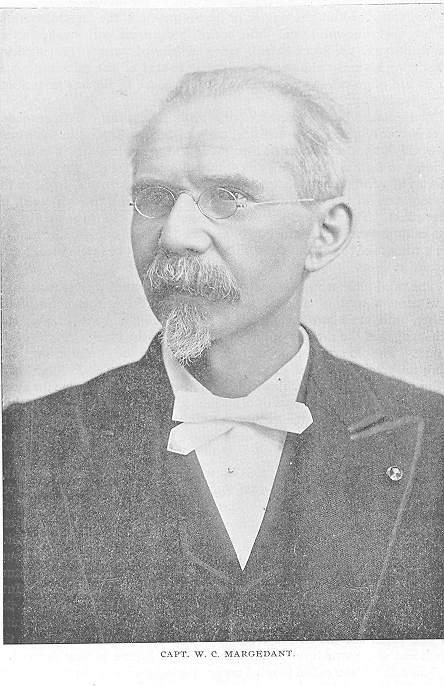
THE CENTENNIAL ANNIVERSARY OH HAMILTON, O. - 63
of the Miami Valley. Covered with canvass, peeping out through the rents in which were the scared children of our forefathers, as the Indians in their savageness, rushed upon the helpless emigrants. This was a stirring scene depicted in all its awful realty, and vividly told of the hardships of those to whom we can give thanks that the celebration of our Centennial ever became a possibility.
Following this came the Goddess of Progress seated upon her imperial throne with the word "Hamilton" glistening in bright golden letters from her breast, covered with her silken canopy, and surrounded by all that the progress a century could bestow. At each corner of this allegorical float was seated respectively the Goddess of Science, the Goddess of Art, the Goddess
of Industry, and the Goddess of Music, representing her own sphere, how her domains had been extended side by side with the domain of the Goddess of Progress. Nothing of an allegorical nature could tell more vividly of our century's progress than did this float.
The last tableau wagon in this division was a wonderful representation of that beautiful German fairy-tale "Schnaa Wittchen"—Snow White. We have all read the story and never before was it so impressively brought before our minds. The queen in all her splendor and the little creatures from dwarfdom brought back to us vivid recollections of our childhood days.
Never before was there a grander pageant brought before human eyes. Every thing that centuries of art and investigation could produce were brought together to make this division a success. Seven beautiful tableau wagons interspersed with Indians. Revolutionary soldiers, weary emigrants and many pioneer ideas and customs made this one of the most attractive: and interesting divisions in the mammoth parade.
In the third division were represented all the great and varied industries of this great manufacturing city. First in size and importance came the Niles Tool Works and Gordon Steam Pump Company with massive floats exhibiting their particular industries followed by their twelve hundred. employes marching eight abreast. Then the Black & Clawson Company the Long, Allstatter Company, the Bentel and Margedant Company, the Hooven, Owens and Rentschler Company, the H. P. Deuscher Company,. the Richy and Dyer Company, the F. & L. Kahn & Bros. Stove Works, the Cincinnati Brewing Company, the Eagle Brewing Company, and scores of others with their thousands of employes, making a grand industrial pageant, unequaled in the annals of such displays, while each had numerous floats indicative of their particular line of manufactures. Many of these floats,. particularly the Brewing Companies were possessed not only of a high degree of artistic merit but appealed strongly to the thirsty thousands who witnessed them that hot September day.
The Mosler Safe and Lock Company had in this division a magnificent safe upon a wagon drawn by four splendid horses. It attracted universal at-
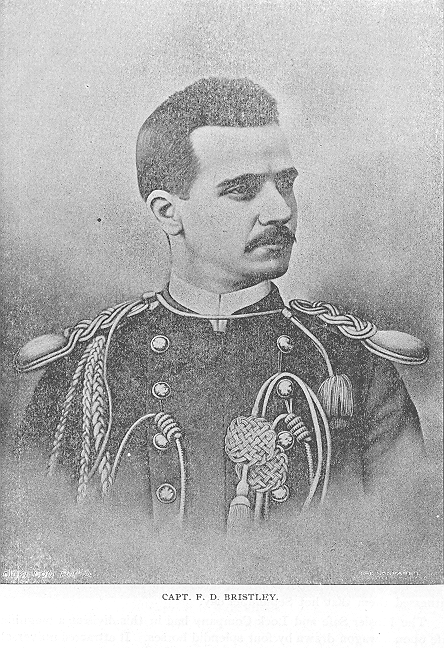
THE CENTENNIAL ANNIVERSARY OF HAMILTON, O. - 65
tention, not only because of its size and beauty of finish, but because the company presented it to the Centennial Committee in which to preserve all the records of its proceedings and the history of Hamilton from year to year until the next Centennial Celebration.
The business then of the city vied with the manufacturers in the exhibition of their wares.
Large and expensive floats upon which were conducted in many instances, their business as carried on daily in their stores.
J. Pabst and Sons' float was business and beauty. It was 18 feet long and 10 feet, wide and was handsomely decorated with flags, bunting, frieze and flowers. In the center was a large pyramid of bottles representing the various drinks, beers, etc, which the firm bottles. The pyramid was surmounted by a large ginger ale bottle. At each corner of the wagon was a pretty young girl in costume and in the center of each side was an artistically painted and decorated cider tub with signs of various articles.
GROTTO AND GNOMES.
The Tile Works float was a beautiful thing. It was the idea and Nandi work of Otto Metzner who had employed himself upon it at odd moments for :several weeks. The float was the representation of a tile kiln located in the grotto and run by wee, wizened gnomes. The grotto was twenty feet long and sixteen feet high and looked rocky and real. The kiln was in the middle and the gnomes were firing up, and burning small tile, which they threw warm from the furnace, into the crowd. The tile were neat little souvenirs of the Centennial. Volumes of smoke made by a chemical process, poured from the smoke stack of the kiln. There were two tableaux on the float, the one in front representing Columbia and two Greek attendants and the one in the rear being an allegory "Industry." Five heralds in the garb of the sixteenth century and carrying banners preceded the float, and five horses with gay trappins drew it in the procession. There was a man in uniform at the head of each horse. The Tile Works float was universally .admired and commented upon and was really one of the most artistic in the parade.
H. J. Earhardt & Co's. float was built upon an elegant new delivery wagon. On the platform and beneath an arched canopy of flowers, flags, and frieze, there was a splendid specimen of a modern anthracite stove. In the rear was a practical tinner, shown in the act of making tin cups. He had all the necessary tools at his side, and as fast as he made the cups he scattered them broadcast among the crowd.
A UNIQUE, EXHIBIT.
F. P. Stewart's idea in connection with their monumental works was an excellent one. They were represented in the parade by a huge decorated stone wagon. They showed the progress of the century in monumental architecture. On the wagon was a large beautiful and costly modern monu-

THE CENTENNIAL ANNIVERSARY OF HAMILTON, O. - 67
ment—a sarcophagus, of splendid design and finish, and near by was the stone memorial tablet of a hundred years ago. The progress of the art was apparent in the difference.
GROWTH IN MUSIC.
Diehl and Co's. float represented a century of Hamilton's growth in. music. On the front part of the float there were Indians in native costume, beating "tom-toms" and singing war songs. In the rear was a Pneumatic Symphony organ. It played difficult and classical music. Among the-pieces are 5th Symphony, Bethoven ; Symphony, B. minor, Schubert; Rhapsodic Hongroise William Tell overture, etc., etc.
AN EXACT DUPLICATE.
One of the greatest floats in the Third or industrial division was that of Tully & Dowling, the popular High street tailors. Their originality and thoroughness was never displayed to greater advantage than in this parade. The float was simply an elevated tailor shop on wheels. The floor was 10X20 feet in dimensions, and was the exact representation of their merchant tailoring establishment itself. The float was elaborately decorated and over all, in sweet flowers, was the typical "goose," square and shears of the time honored profession. And there were the counters, over which Jim presided himself. There were the goods, the suitings, the overcoat-ings etc., etc. Jim was just as busy selling them there as if he had been in the store. And there was Toni with his square and shears, the pattern was quickly made, the suit or overcoat or whatever it was, cut out, transferred to the tailors who were also there, busy with the needles that plied their shining spears. quickly in and out, and there was the machine that great invention that did the work as fast as the hand could supply it. In short, from that wonderful. wagon, an entire suit was ordered, made, furnished and delivered and with a fit that had the symmetry of the natural cuticle itself. The young and genial gentlemen of the firm, Mr. James 'Tully and Mr. Tom Dowling, couldn't possibly have thought of a more popular display. They gave an exact reproduction of their shop and business methods and in fact simple transferred themselves for a few hours from their shop to the wagon and business went on uninterrupted. They were a most happy and feiecitous factor in the industrial representation.
S. H. Millikin's carpet store made a big and elegant display on their float. It was a hugh affair, drawn by four gaily decorated horses. The animals were covered with flags and bunting and wore fancy clusters, for plumes. The float itself was 9x15 feet in size and was the skeleton of a house, covered entirely with beautiful and expensive carpets, rugs and. portieres. Along the sides rolls of carpets were piled in tiers. The front was tastefully hung with portieres, and at the back hung a beautiful and expensive deer rug, 9X12 feet in size and completely covering that end of the float. Along the sides of the float and below the house were various signs-
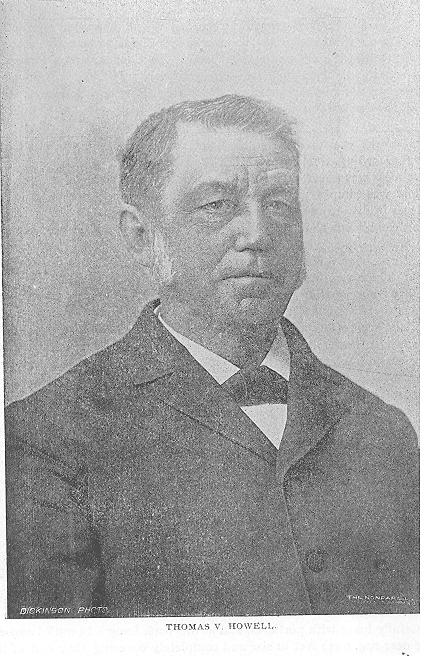
THE CENTENNIAL ANNIVERSARY OF HAMILTON, O. - 69
and announcements. The display was essentially modern and elegant. Salesmen in continental attire, old fashioned suits and powdered wigs formed a part of the display. The plan of this association was to convey the idea of progressiveness.
There was one float that attracted an unusual amount of attention on account of the striking originality and daring of the idea. It was the float of the Panhandle Railroad Company, and was a box car of the size and proportions of a regular car. It was built on a frame work and covered with canvas and painted to represent a Union Line car which is the Panhandle Eastern Fast Freight Line. In the parade it was manned by the little son of Yardmaster Welsh. The car was 28 ft. long, 8 ft. wide and 8 ft. high and is marked for a 6o,000 lb. capacity which is about the avarage capacity nowadays. The light weight of the car is placed at I79 t pounds and the number of the car 1891, which brings in the centennial. Ticket-agent Ray originated the idea of this float, and afterwards saw that it was carried out. It represented the Panhandle, particularly the freight department and incidentally it showed the progress of the last twenty-five years in railroading.
The Cincinnati Hamilton and Dayton Railroad was represented in the Parade by an exact reproduction in minature, of its famous Vestibule Limited, Chicago Passenger Express Train. It was a masterpiece of artistic composition in execution and design.
The Company's summer resort, Woodsdale Island Park, helped swell the parade, and produced great amusement among the children and others, by their donkeys and carts and other amusing features of the famous resort.
Charles Richter's blacksmith shop just behind W. C. Frechtling & Co. was “in the procession" and kept up with it right along. That's a way he has anyhow. He also had his wagon there. There was a horse on the wagon, and a portable forge. There were three of the best horse shoers in the country there, and on the wagon they took the crude iron, molded it skillfully and scientifically into shoes, trimmed the hoofs, applied and swiftly attached the shoe and that horse was as clean shod and correctly right there and then as ever a horse in miles around. The float was one of the most originally decorated in the parade.
HARDWARE AND STOVES.
The Jacobs Bros, float was a complete exposition of their business in all its branches and received much favorable comment for its general excellence. It was a miniature store room and was really a work of art. The roof was covered with slate, so arranged so as to show the sign "Jacobs Brothers 1891" prominently in red, On top was an artistic cresting of galvanized iron and the cornices were also of galvanized iron. Around the sides of the float were appropriate signs in ornamental lettering. In the center of the store room were several magnificent base burners of the most expensive and modern design and finish, around the sides hung hardware, saws, hatchets,
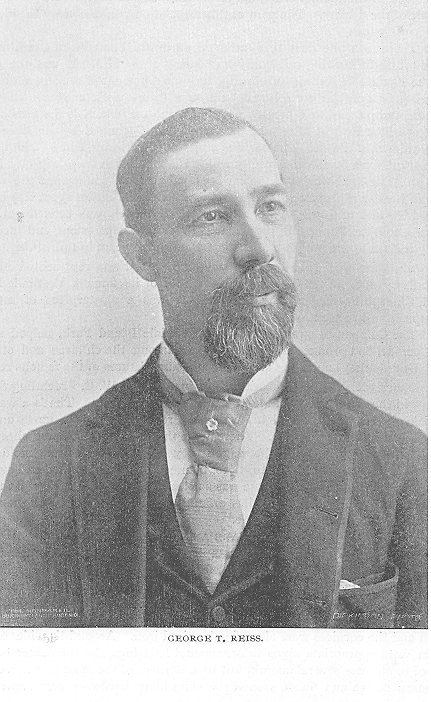
THE CENTENNIAL ANNIVERSARY OF HAMILTON, O. - 71
chisels, bits, etc. of the finest quality. On the platform back of the store room were kegs of nails. The exhibit displayed the four branches of Jacobs Bros. business.
A SPLENDID EXHIBITION.
Gilcrest and Millikin had a float indicative of their business. Upon it were wax figures neatly attired in what is latest in the clothing line. The float was nicely decorated and drawn by four magnificent horses.
One of the most attractive floats in the procession was that of the Fisher Canning and Preserve Works on which was an artistically arranged pyramid of canned goods, It attracted general attention and was highly spoken of many other beautiful floats representing the different business enterprises of the city were in the procession besides many of the features of great interest such as Indian scouts painted and armed for the war path. Companies of pioneer soldiers dressed in Continental costume as of one hundred years ago.
One of the most attractive features of the parade was he Chief of the Second division, Capt. Metzner, dressed as General St. Clair, and all his staff dressed as Continental officers with their long gowns and white uniforms.
The parade of Fairfield Towhship to which was awarded the prize banner for the best exhibition by any township was the best representation of pioneer clearing, log cabin, coon hunting, ox-wagon and old spinning wheel and hand loom weaving ever witnessed in the Miami Valley. It is exceedingly doubtful whether an exhibition at the end of the next century will be able to present so many genuine pioneer features.
The parade was reviewed by Governor Campbell and staff, the Grand Marshal and Assistant Marshals and their respective staffs, in front of the •court house, when it disbanded and the grand marshal and staff, division .commanders and staffs formed in their respective places as soon as the procession had passed the grand stand, and escorted the governor to his headquarters, and the Great Parade had passed into history,
Promptly at 7:30 that evening was begun the great fire works display. It is unnecessary to attempt to describe it ; language would fail. The program printed in this book will give some idea, although a faint one of its magnificence. It is sufficient to say that the program was fully carried out in every particular and the wondering multitude returned to their homes -satisfied that they had seen the greatest pyrotechnical display ever presented in Ohio, The Centennial Celebration was over. It was a success from every point of view. The men and women too, who made it such, felt fully repaid for all their labors. To organize such an enterprise and to conduct it to such a successful issue, required not only long and continued application, but to a great extent the neglect of private business.
The people of Hamilton with but few exceptions deserve all praise for their aid and encouragement ; and to the daily press of the city the News and
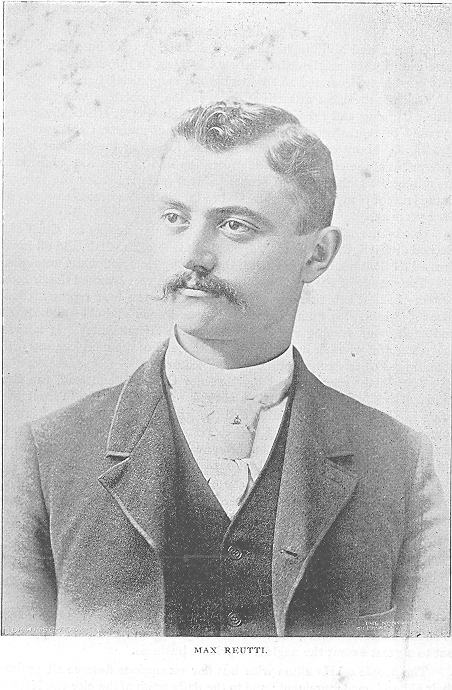
THE CENTENNIAL ANNIVERSARY OP HAMILTON, O. - 73
the Democrat, all honor is due. These papers and also the Hamilton Herald and Volks Stimme, used their columns freely to advertising all the preliminaries, and the first day crowned their journalistic enterprise by their reports and illustrations of the celebration itself.
In the early part of the preparations it was determined to preserve and perpetuate the whole proceedings in book form, for the benefit of future generations. Isreal Williams; Rev, Edward W. Abbey and John F. Neilan of the Centennial Committee were appointed by that committee to prepare the matter for this book, with full power to arrange all the details and have it published. The committee has performed the labor assigned it and the result is before the readers. The articles: The Courts, Transportation and Communication by rail and otherwise, Hamilton in Literature, Hamilton in. Politics, and others were presented by Mr. Williams.
The Historical Introduction, and The History of the Centennial and Description of the Celebration, Parade, and Fire Works were prepared by Mr. Neilan.
The other portions of the book were compiled by various church officers and others and were edited by Hon. D. W. McClung, of Cincinnati, Ohio, a former well known citizen of Hamilton.
This description of the parade and the different manufacturers and business firms having floats therein is necessarily incomplete, because composed mostly from memory, a long time after the event had passed and was almost forgotten. Provision had been made by the Committee for a complete history of the celebration and parade at the time by an eye witness, but for some reason it was not done. This will account for any failure to note all the attractive features of the parade as it is impossible to remember at this time all the parts of that immense procession.
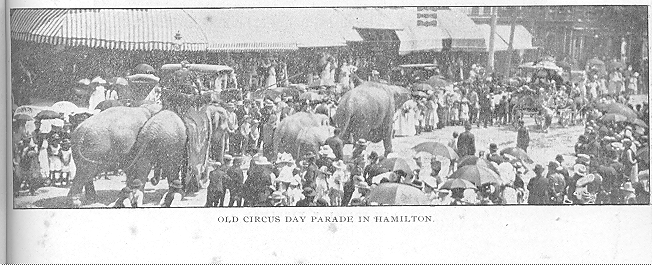
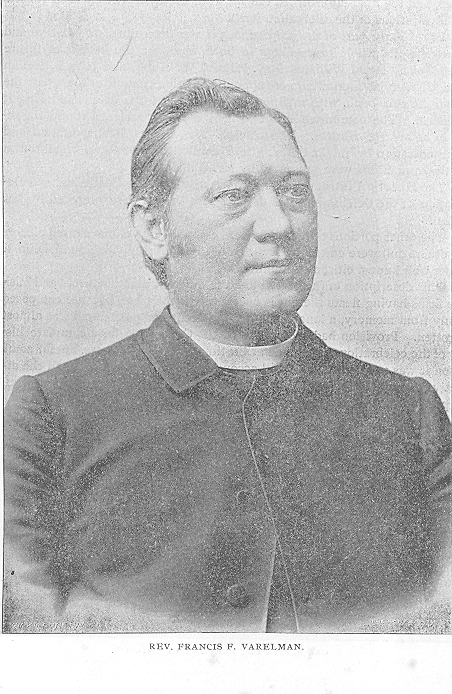

PART II.
ADDRESSES AID ORATIONS
--BY--
Prominent Speakers an citizens.
HAMILTON , OHIO.
THE CENTENNIAL ANNIVERSARY OF HAMILTON, O. - 77
OPENING ADDRESS.
BY THOMAS MILLIKIN.
Mr. Chairman, Ladies and Gentlemen:
IT WAS a noble and laudable public sentiment that prompted this celebration. We are here without distinction of political party, of religious opinion, of age, or sex, or race or nationality to perform a great public duty. We are here to perform a filial as well as a patriotic duty—a filial duty we owe to our forefathers who risked their lives and their fortunes in subduing the wilderness and its savage inhabitants, and in laying strong, wide and deep the foundations of our great civilization—a patriotic duty we owe to our government for the great ordinance of 1787—for its wise laws, for its patriotic and efficient public rulers and for its military aid.
The cession in 1785 and 1786 of the Great Northwest Territory to the Congress of the United States imposed upon it the duty of extinguishing the Indian title and protecting the inhabitants from a merciless Indian warfare. For this purpose Fort Washington at Cincinnati was built and garrisoned, and Arthur St. Clair was appointed Governor of the Territory and Commander of its armies.
In August, 1791, General St. Clair determined to erect another Fort on the east bank of the Great Miami River. He ordered Major Ferguson to mark out the ground for a small Fort to be enclosed with pickets and bastions—to employ all the men that could be spared for that purpose in cutting down pickets and carrying them to the place where they were to be put up. He suggested that it would require twelve hundred pickets—that they must be twenty feet long—straight—from nine to twelve inches in diameter—they were to be butted at one end, and sharpened at the other, and placed firm and upright in the trench, and close together— a thin piece of timber called a ribband to be run around the whole near the top of the pickets to which it should be fastened with wooden pins.
There were, besides, inside pickets, one between every two of the others —a bastion on the east and another on the west on which platforms were erected to scour the country east of the Fort with artillery, and to command the ford and the river for some distance up and down. There were barracks for one hundred men—a guard room—two store houses for provisions and barracks for the officers inside.
The Fort was completed in about fourteen days. The work was done almost entirely by the labor of men. In performing this labor he suggested that three men could easily cut down, butt and point five pickets, and that seven men (six of whom with handspikes) could carry them to the ground-

THE CENTENNIAL ANNIVERSARY OF HAMILTON, O. - 79
that working parties should be divided into squads of ten (in every one of which there should be three good axemen) and furnished with poles of the exact length the pickets were to be cut.
These were the simple instructions for building the Fort. The implements used in performing the work were the cross cut saw, the auger and the axe. The Fort was completed September 30th, 1791, and then named "Fort Hamilton."
Three years later the town of Hamilton was laid out on the same spot. Wayne's victory at the battle of Fallen Timbers ended the Indian war. The Fort was dismantled, the town grew into a city, and now, after the lapse of a hundred years we have met to celebrate the inauspicious event which culminated in making this one of the most enterprising and beautiful cities of the land.
One hundred years ago the spot on which we stand was an unbroken wilderness. The woodman's axe had not resounded in the solitude of the woods, except in clearing a pathway for the invading army of St. Clair, or in cutting timbers for the Fort. The drum beat at break of day had not aroused the soldier from his sleep, nor had the trumpet sound at sunset given notice for him to retire.
The banks of our beautiful river were fringed with noble trees. Its waters were undisturbed except by the flutter of numerous flocks of water fowl, and the deer, elk and bison slaking their thurst in the stream, and by the paddle of the Indian canoe.
But the building of the Fort, the march of the armies, the dreadful battles fought, resulting sometimes in disastrous defeat but eventually in triumphant victory, put an end to the Indian title and savage rule, and gave this beautiful Miami valley to civilization.
We look back from this day through a hundred years—through a century of marvelous growth and development. The same sky is overhead, the same sun shines upon us, the same river that in January, 1791, bore upon its bosons the canoes of Simon Girty with three hundred Indian warriors to the attack upon Dunlap's Station, and in September of the same year flowed past the site of Fort Hamilton, still flows in its channel. The same hills that stood sentinel over the valley, and looked down upon the old Fort are still here, but stripped of the magnificent oaks that were their glory.
But how changed everything else. The old Fort has disappeared and in its stead we have a city of twenty thousand inhabitants. The noble forests have disappeared beneath the stroke of the woodman's axe and in their place are farm houses, orchards and cultivated fields. The military roads cut out with so much labor for the passage of St. Clair have been succeeded by turnpikes,, canals and railroads.
We contrast today the rude Fort with our new Court house, our school buildings, churches and private residences—models of comfort and of architectural beauty. We contrast the simple tools used in building the stockade.
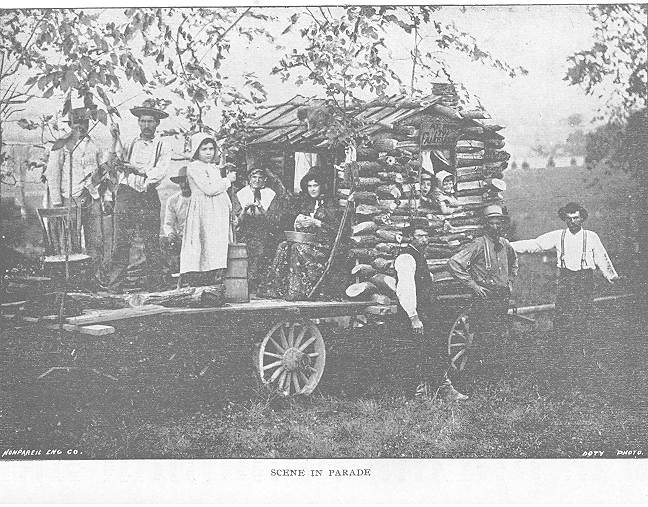
THE CENTENNIAL ANNIVERSARY OF HAMILTON, O. - 81
Fort in 1791, with the products of the manufacturing shops of our city, with the Corliss Steam Engine—with the machines for bending steel armor plates for ocean vessels--with the power punches and shears—with the paper-mill machinery,—wood working machinery—with every variety of agricultural implements—with the safe works and stove works and tile works—with the flouring and woolen mills—and with the various other products of our shops, all of which have justly given to this city, not only a State and National reputation, but a reputation throughout the civilized world, as a great manufacturing center.
We make this contrast not so much in boast of our own achievements but as a greatful recognition of the services of our forefathers, who laid the foundation and gave us the opportunity for success.
In the year 1835 the citizens of Hamilton celebrated the forty-fourth anniversary of the building of the Fort. It was conducted exclusively by "Buckeyes," but all other citizens were invited to attend and participate in the celebration.
The term "Buckeye" was defined to embrace all who were born in the State, or who emigrated to Ohio under the age of five years, and all who resided in Ohio previous to the adoption of the Constitution in 1802.
Those who were prominent in conducting the celebration were: Lewis D. Campbell, Henry S. Earhart, William B. Van Hook, Ezekiel Walker, William Bebb, Joseph Lee, William Taylor, Charles K. Smith, Jeremiah Morrow, Jr., Samuel Walker, William C. Woods, Samuel Johnson, John B. Weller and James Rossman.
But one of these prominent and patriotic citizens survive. That one is James Rossman, one of the venerable Vice Presidents of this assembly—a man whose life is without reproach, who now bearing the infirmities of eighty-nine years, unites with us with what strength remains to him in paying a just tribute to the memory of the pioneers, and in celebrating the centennial of the building of Fort Hamilton.
There were present upon that occasion—fifty-six years ago—many surviving soldiers of the war of the American Revolution—in enwho fought at Camden, Eutau Springs, Kings' Mountains—who wintered with Washington at Valley Forge—crossed with him the Delaware at midnight, and at break of day won the signal victory at Trenton—men who fought at Brandywine, Saratoga and Yorktown. These veterans, when the revolutionary war ended had come to this Northwest Territory to locate their military land warrants, given to them in payment for their services. The third range of townships on which the City of Hamilton now stands—six miles wide and extending from the Great to the Little Miami River—having been set apart for that purpose by Congress.'
There were, likewise, many present in the celebration of 1835 who were soldiers under St. Clair and Wayne, who had personal knowledge of Dunlap Station and Girty's attack upon it- -who were at Fort Hamilton—who were
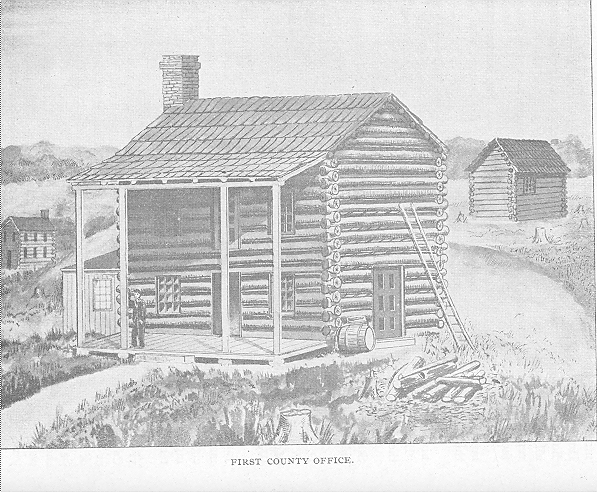
THE CENTENNIAL, ANNIVERSARY OF HAMILTON, O. - 83
in the disastrous defeat of St. Clair on November 4, 1791, and who were with Wayne when his legion with fixed bayonets and trail arms, charged and completely routed the Indians of Fallen Timbers in 1794.
These soldiers and pioneers were living witnesses of the memorable event we have met this day to celebrate, and their presence added greatly to the interest of the occasion. Not one of tnem are with us today.
In the Buckeye celebration of fifty-six years ago the accomplished orator of the day, William Bebb, an eminent member of the bar of this county, and at a subsequent period Governor of the State, in his eloquent oration comparing the progress of this country to that of the old, said:
"If our career of national greatness commenced at a later period than that of the nations of the old world, does it not follow that the last may be first, and the first last? If we have, fewer towers crumbling to ruin, we have more states rising to grandeur. If we have less in the past to boast of, we have more in the future to hope for."
And then with prophetic inquiry he asked
"Who, looking at our progress during the last half century, shall set limits to the improvements of the next ? What imagination shall now dare set bounds to the resources of this great valley of the West, as it will appear to our children, when fifty six years hence, they assemble on this spot to celebrate the first centennial of the completion of Fort Hamilton? When thevillages of the West shall have grown into cities, and the population shall have increased to many millions ; when its rivers shall have been united at their sources by canals and railroads, with the Atlantic rivers on the East, with the lakes of the North, and, perhaps, with the Oregon of the far West; when all our territory east of the Rocky Mountains shall have heen formed into States, and admitted into the Union."
The voice of the orator has long since been stilled in death. The fifty-six years have elapsed, and the children of those who participated in the celebration of 1835 have assembled on this spot to celebrate the first Centennial Anniversary of the completion of Fort Hamilton.
They are here to answer the prophetic inquiry and to say that the imagination of the eloquent orator fell far short of what has become reality. We exhibit today an indestructable union of States, extending from the Atlantic Ocean not only to, but over and across the Rocky Mountains, and to the shores of the Pacific. We exhibit the villages of the West grown into magnificent cities, and the population increased to many millions. We exhibit a country rich in everything that should make it great and respected—the North and South, the East and West bound together by a written Constitution, imparishable only by the will of the people—bound together by the same illustrious ancestry and national history, by a brotherly love and by a common interest. We exhibit a happy, contented, intelligent and prosperous people.
For this grand result of a hundred years growth and development we would give a large share of gratitude and praise to those who gave us the ordinance of 1787—who subdued the wilderness, and the savage foe, to the Western Pioneer, to the builders of Fort Hamilton.

THE CENTENNIAL ANNIVERSARY OF HAMILTON, O. - 85,
HAMILTON, 1791-1891.
ADDRESS BY L. M. LARSH.
Mr. President, Ladies and Gentlemen, Citizens of Hamilton :
I CONGRATULATE you on this auspicious occasion, At this time you are endowed with as many of the attributes of genuine happiness as any community within the limits of the civilized world. You are blessed with good health, renumerative employment, excellent schools and churches, with good laws well administered, with prosperous manufactories and other business occupations, with superior railroad and other transportation facilities, with excellent farm lands surrounding and which are well cultivated, and with every facility for social, intellectual and moral enjoyment you are freeest of the free, richest of the rich and proudest of the proud. Your men bravest of the brave, and your women, fairest of the fair. In this your Decennial year 1891 you are most prosperous of the prosperous, and may I not also truthfully add the happiest of the happy.
Will you for a few moments take a retrospect with me for one hundred years to the initial period of our city's organization, whose centennial we are now so joyously celebrating. Until the year 1791, no community existed here, no whiteman had habitation or home. The savage man and savage beast held undisputed sway, their will through perpetual warfare was the ruling power. No progress was or could be made in any place under such domination and that condition of existence would have continued until now had not the Whiteman obtruded upon this savage solitude. The savage man was as incapable as the savage beast of intellectual or moral progress without contact with extraneous reformatory influences. Our pioneer forefathers were not idealish and perhaps they were not properly speaking reformers, they were practical eradicationists. They acted upon their well founded belief that the most certain road to successful competition with savage man and beast was to exterminate them, and they acted energetically and persistently to secure that end, and as a consequence the community was soon rid of both, and the joy of prosperity and happiness took root and grew apace. The power of military dictation, first controlled in the stead of the savage man and his contemporary, the savage beast, then quickly followed the organization of the civil polity—organization took the place of the military dictum. The court house became the successor to the military camp, industry succeeded idleness, the forests disappeared and in their stead came cultivated fields the inclosure that constituted the Military Fort erected by General Arthur St. Clair and afterward enlarged by General Anthony Wayne formed the first nucleus of our now prosperous and pleasant city, as time rolled on, the then feeble village added to its growth, it did not like Johna's Gourd spring into full existence in one night, but rather like the sturdy oak that from small acorns grow. It grew slowly at first and more gradually afterwards and still more vigorously as surrounding influences operated in its behalf, until now it has become a prominent factor in the aggregation of
communities that constitute the great State of Ohio.
Citizens of Hamilton, Ladies and Gentlemen and Mr. President before taking my seat I again cordially congratulate you.
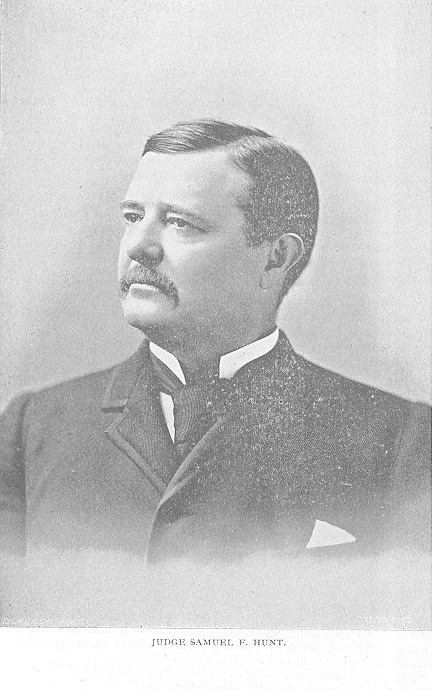
THE CENTENNIAL ANNIVERSARY OF HAMILTON, O. - 87
THE MIAMI VALLEY, 1791--1891.
RESPONSE BY HON. SAMUEL F. HUNT.
The President then presented Hon. Samuel F. Hunt, Presiding Judge of the Snperior Court of Cincinnati, as one of the Ohio Valley boys, and known to ex cry one present. Judge Hunt said
Mr. President, Ladies and Gentlemen:
IT is most interesting, after one hundred years have passed, to look back over the history and progress of a people, and trace the civilization which began in the clearings of the seemingly unending forests, until it has reached almost imperial power. These frontier people, who won this Valley from the wilderness, were strong and freedom-loving, and characterized by a bold defiance of hardship and clanger. They realized that they had been ordained for a great work, and they possessed the faith that enabled them to pass under the hard conditions of life only to be found in the fathomless depths of the woods. They cleared the acres with the axe, and defended them width their rifles. They believed, in the language of the great Ordinance that religion, morality and knowledge, being necessary to good government and the happiness of mankind, schools and the means of education should ever be encouraged. The soil, too, had never been cursed by the unrequited toil of the bondman. Civil jurisdictions were established on the broad foundations of justice and humanity,
THE VALLEY AT THE TIME OF THE PURCHASE.
When the original contract had been entered into for the Miami Purchase, John Cleves Symmes, the purchaser, issued an address concerning the country. It was dated at Trenton, New Jersey. November 26, 1 787, and is addressed to the "respectable public," and it is evident from the character of this immense gathering that their descendants are present to take part in these interesting exercises.
John Cleve Symmes had been an officer in the Army of the Revolution, Chief Justice of the State of New Jersey, and a member of the Continental Congress. He says, in that address, that from his own view of the land bordering on the Ohio river, and the unanimous report of all those who have traveled over the tract in almost every direction, it is supposed to be equal to any part of the Federal Territory in point of quailty of soil and excellence of climate. The winters were represented as moderate, while there was no extreme heat in summer. He pictured the situation as one to command the navigation of several fine streams, and boats were frequently passing by the land as they ply up and down the Ohio. There were no mountains in the track, and excepting a few hills the country was generally level and free from stone on the surface of the earth ; but there were plenty of stone-

THE CENTENNIAL ANNIVERSARY OF HAMILTON, O. - 89
quarries for buildings. It was described to be well watered with springs and rivulets, while several fine mill-streams fell from the dividing ridge into the two Miamis, which were about thirty miles apart. These rivers were supposed to be navigable higher up in the country than the northern extent of the Purchase, so that the interior farms would have navigation, in the boating season, within fifteen miles at furtherest. He added that, for the quantity, a large proportion of the land, in the Miami Purchase, was supposed to be of the first quality, and the whole equally good compared generally with the land of Kentucky.
The Secretary of War had given the assurance of a friendly disposition to support the settlers against the Indians, by replacing a garrison of Federal troops in the Fort which was then remaining on the land at the mouth of the Great Miami, and would greatly facilitate the settlement, and in some measure render safety to the first adventurers.
The mill-streams as are thus described as falling from the dividing ridge of the Miamis are doubtless Mill Creek, the dry fork of the Whitewater, Indian Creek, Four Mile and Seven Mile, and Twin Creek, and others, while the rivulets are those which to-day sing as merrily as they flow from the upper lands of the Valley as they did one hundred years ago.
THE NAVIGATION OF THE GREAT MIAMI ONE HUNDRED YEARS AGO.
We are accustomed to associate the Great Miami with only the light canoe of the Indian, and picture the quiet expanse of water as only broken by the graceful motion of innumerable wild fowl. Probably the first printed notices of the Miami rivers will be found in the explorations made in the Western wilderness, between the years 1764. and 1775, by Captain Thomas Hutchins, of His Arittanic Majesty's Sixteenth Regiment of Foot, and published in London in 1788. The writer says that the Little Miami is too small to navigate with bateaux ; its high banks and gentle current prevent its much overflowing the surrounding lands in freshets. But the Great Miami Afferemet, or Rocky River, has a very strong channel, a swift stream, but no falls. It has several large branches, passable with boats a great way.
It is not strange that the two Miamis were supposed to be navigable for some distance in the country at that time, for it was not until some years afterwards that Robert Fulton conceived the design of propelling vessels by steam, and a number of years elapsed before even his views were put into practical operation.
John Cleve Sy mores, as early as May 18, 1789, in a letter to one of his associates, hesitated whether the great commercial emporium of the Miami country should be located on the Ohio river, or on the bank of the Great Miami, in a large bend, some twelve miles from its mouth, or near the present site of Miamitown. He was ready to grant that more trade would pass up and down the Ohio, and many more boats would constantly ply on a river thirteen hundred miles in length, but with a just pride in the
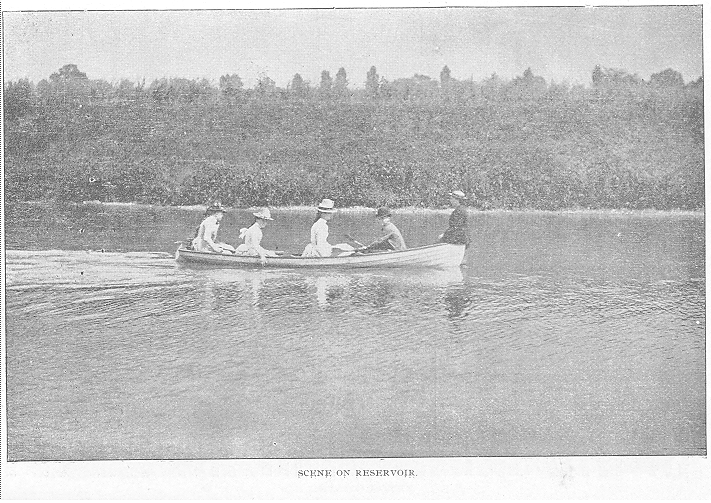
THE CENTENNIAL ANNIVERSARY OF HAMILTON, O. - 91
Purchase, he urged that the extent of country, spreading for many miles, on both sides of the Great Miami, was, beyond all dispute, equal, if not superior in point of soil, water and timber, to any tract of equal contents in the United States. In a very few years, from this Egypt on the Miami, would be poured down its stream to the Ohio the products of the country from two hundred miles above the mouth of the Great Miami, with no rival city or town to divide the trade of the river.
Judge Symmes again refers to the Great Miami river in a letter on September 17, 1791, from North Bend, to Jonathan Dayton. He speaks of the army of St. Clair having advanced some twenty-five miles and then building a fort on Boudinot's land—the City of Hamilton of to-day. The day before a boat with one hundred and twenty barrels of flour attempted to ascend the Miami river. This should have been done he thought in progues, or large canoes of one ton or one and a half tons burden, and it would have succeeded.
Some of the wounded at the defeat of St. Clair were brought down the Miami from Fort Hamilton to Fort Washington, for General St. Clair, under date of November 20, T791, writes to Captain John Armstrong, then in command at this place, that the boat which should have replaced the one that brought the wounded, after struggling some days against the current of the Miami, making but two or three miles, had returned that night. There are those here to-day who have seen keelboats, tied to the banks of the Great Miami, at Hamilton, to bear the produce of the Valley to distant points on the Ohio.
It may not now carry the commerce of a great people on its boson, and its peaceful waters may not be ruffled by the keel boat or even the progue, but the gently-flowing Miami, as it winds through this fertile valley, rustling with standing corn and expectant with golden harvests, is dearer to us than the blue Danube with all its poetry or the Rhine with all its legends.
THE VALLEY AS IT APPEARED IN I791.
In a letter to Jonathan Dayton, written as early as 1789, Judge Symmes refers to the country as healthy, and that it looked like a mere meadow for many miles, and Oliver M. Spencer, in an interesting narrative, furnishes a glowing picture of the Valley as it impressed him in 1791. This was before the axes range in all the woodlands, and before the towns smoked in all the Valley. This was before the log-rollings and house-warmings and barn raisings and corn-schukings and country-quiltings had been exchanged for the latest waltz or progressive euchre. He say,, "the winter of 1791-2 was followed by an early and delightful spring; indeed, I have often thought that our first Western winters were much milder, our Springs earlier, and our Autumns much longer than they now are. On the last of February some of the trees were putting forth their foliage; in March the redwood, the hawthorn and dog-wood, in full bloom, checkered the hills, displaying
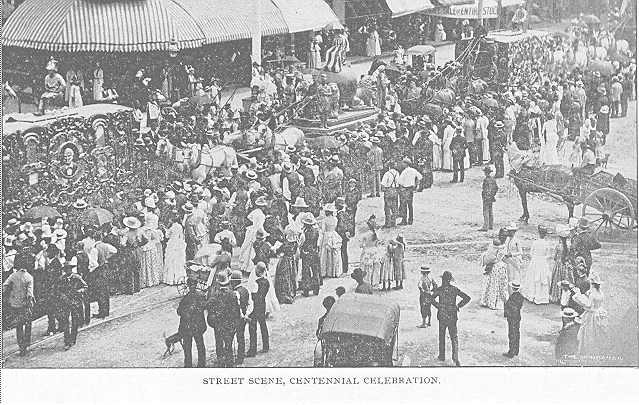
THE CENTENNIAL ANNIVERSARY OF HAMILTON, O. - 93
their beautiful color of rose and lily ; and in April the ground was covered with May-apple, blood root, ginseng, violets, and a great variety of herbs and flowers. Flocks of paroquets were seen, decked in their rich plumage of green and gold. Birds of various species and every hue, were flitting from tree to tree, and the beautiful red bird, and the untaught songster of the West made the woods vocal with their melody. Now might be heard the plaintive wail of the dove, and now the rumbling drum of the partridge or the loud gobble of the turkey." He then speaks of the clumsy bear, moving doggedly off, and the timid deer, aroused from his thickest and clearing logs and bushes at a hound. There was, however, still the apprehension of the wily copperhead, waiting to strike his victim, and the horrid rattlesnake, more chivalrous, but ready to dart upon his foe, and the still more fearful and insidious savage, who, crawling upon the ground or noiselessly approaching behind trees or thickets sped the deadly shaft or fatal bullet.
CHARACTER OF THE EARLY SETTLERS OF THE MIAMI VALLEY.
The pioneers of the Miami Valley were compelled to act largely without precedent and to meet contingencies which could not have been anticipated. These back-woodsmen were the van-guard of that great army of the advance which won the territory from the Alleghenies to Grande and the Pacific. It is true that the pioneers from Virginia and North Carolina had crossed the mountains into Kentucky and East Tennessee, but they did not reach the Ohio river until some time afterwards. There was some interest manifested in the lands between the Miami rivers as early as the summer or fall of 1788, but the first attempt for the settlement of the Miami country set out from the older districts of New Jersey and Pennsylvania. There was no settlement before that time for fear of the Indians and the total want of military protection. Judge Symmes left Yew Jersey, late in July,. 1788, with a train of fourteen four-horse wagons, and with sixty persons, in: wagons and on horseback, including his own family.
The descendants of the men who settled the Miami Country can trace their lineage to a good stock. They came, in the first place, from a race historically bold, and some of them were officers and soldiers who had been educated in the severe and patriotic school of the Revolution. They came from New England, New Jersey, Pennsylvania and Virginia, while Kentucky gave one of the original proprietors of Cincinnati and one of the founders of Lane Seminary. The `'crosses" of blood are shown in the generations that have peopled this Valley, and in the social institutions, which were founded, and in the sacredness which eveiywhere invests life and liberty and property.
Mansfield in his life of Dr. Drake pays this just tribute to the pioneers who settled the Miami Country. '`There were among them, too, men of great strength and intellect, of acute powers, and of a freshness and originality of genius which we seek in vain among the members of conventional society. Some were soldiers in the long battle against the Indians ; some
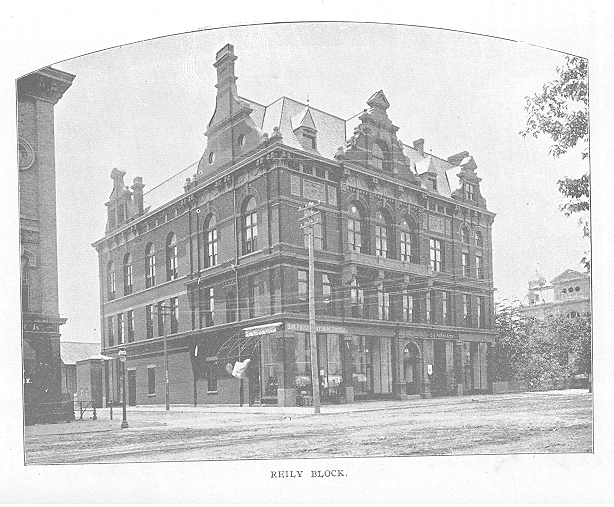
THE CENTENNIAL ANNIVERSARY OF HAMILTON, O. - 95
were huntsmen, like Boone and Kenton, thirsting for fresh adventures ; some were plain farmers who came with wives and children, sharing fully in their trials and dangers ; some were lawyers and jurists, who early participated in council and legislation ; and with them all, the doctor, the clergyman, and even the schoolmaster was found, in the earliest settlements. In a few years others came whose names will long be remembered. They gave to the strong and rude body of society here its earliest culture, in a higher knowledge and a purer spirit."
Many of them brought their religion with them, too, for it has been said that the early Scotch-Irish Presbyterians of the Miami Valley were the kinsmen of the Covenanters.
THE MIAMI VALLEY IN 1891.
But the days of the station or stockade fort and the block-house have passed away, although they played an important part in the history of the back woods. The puncheon floor and the roof of clapboards have given way to the more commodious homes made necessary by an advancing civilization. The buck antlers no longer hold the ever trusty rifle, and indeed the buck antlers themselves have disappeared.
The attack on Dunlap's settlement, not far from Venice, in this county, on January 10, 1791, led by the infamour Simon Girty, at the mention of whose name the women and children of the Miami country turned pale, and the attack on Whites Station on the old Hamilton road, at the third crossing, of Mill Creek, on October 19, 1793, read like one of Cooper's novels.
It seems strange to us that Colonel Robert Elliott, a contractor for supplying the United States Army, should have been killed by the Indians, at the old Fleming place, near Springdale, while on his way from Fort Washington to Fort Hamilton, while some pack-horsemen in the government service while stopping at the first little stream which crosses the Springdale turnpike below Carthage to give their horses drink would receive such a volley from the Indians as to give the name of Bloody Run to the stream—a name it holds to this day.
The "clearings" which were bounded by a dense region of shadowy woodland which encircled the cabin door have extended into cultivated farms, and the spires of churches and chimneys mark the spot of trackless forests through which even the sunlight could not enter to brighten their mysterious aisles.
We stand to-day on the heights of a hundred years—a century crowned by the blessings of liberty and order and good government. There is a just cause for congratulation in the progress of our Valley. It may well challenge comparison with all equal extent of territory in any part of the habitable globe in the fertility of its broad acres; in the character of its water, timber and roads ; in its schoolhouses and academies for higher learning ; in its churches and the catholic spirit which pervades their creeds, and the in-
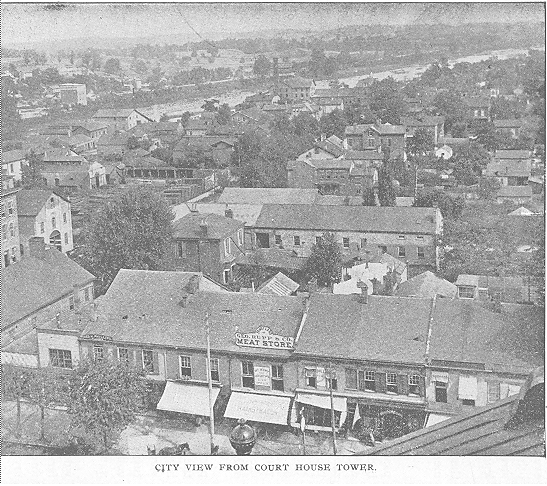
THE CENTENNIAL ANNIVERSARY OF HAMILTON, O. - 97
stitutions for the widow and orphaned children; in the relief which it extends to the homeless and destitute, and in the charity which it offers to the helpless child of want ; in its telegraphs and telephones and fountains and parks and Music Halls and Libraries, in its homes where the incense of domestic comfort rises on so many altars and where household gods are twined with evergreen," in its influences for morality and parental obedience and respect for constituted authority, in the speedy and impartial administration of justice and in the spirit of an undying loyalty to country.
THE PATRIOTIC SERVICE OF HER SONS.
The sons of Miami Valley have met every obligation of good citizenship. Three of her sons, either by birth or adoption, have filled the Presidential chair : eleven have been Governors of Ohio; nine have been Senators of the United States; one has been Chief Justice and two have been Associate Justices of the Supreme Court of the United States; some have been members of the Cabinet; some have represented their country in the highest Courts of Christendom ; some have sat on the Supreme Bench of Ohio ; some served in Congress with great distinction and largely directed National legislation in the important period of the civil war, while one was the first missionary and the first author to carry the Gospel beyond the shores of the Mediterranean.
They were gallant soldiers in the war with Mexico, in the struggle of 1812, and rendered patriotic services on every battle-field in the war for the Union. We remember with lasting gratitude their devotion to their country, and on this centennial day, reverently do honor to the memory of the gallant Butler and those who fell with him on that day of dreadful disaster at St. Clair's defeat, to the memory of those brave and heroic men who followed Anthony Wayne and perished at list at the Fallen Timbers, to the memory of the hardy pioneers who protected the frontiers and saved defenseless settlements from the tamahawk and scalping knife of the Indian, to the memory of every man, whether on land or on sea, who has lifted up his hand for his country.
HITHERTO THE LORD HATH HELPED ITS,
In the midst of these multiplied evidences of material prosperity, and with all these blessings of civil and religious liberty, which enwrap us as gently as our mothers' arms, we can not but look with gratitude to that Providence which directs the destinies of Nations as well as of men. Hitherto the Lord bath helped us.
With an abiding attachment for our free institutions, and with a sublime faith in the future, we now enter upon the second century of the Miami Valley.

THE CENTENNIAL ANNIVERSARY OF HAMILTON, O. - 99
THE STATE OF OHIO
BY JAMES E. CAMPBELL
Ladies and Gentlemen:
THE duty assigned me is to speak of Ohio—the commonwealth which has given birth to many of us ; and of which whether native or adopted children, we all are justly proud.
There is something in Ohio scarcely to be described in words—that possibly does not exist to the same extent in any other state in the Union; that is, the composite, cosmopolitan, mixed blood of her people. The lines of immigration which set into this state when first opened to settlement after the Revolutionary war, were many and varied. There came in a commingling stream, the Huguenots from South Carolina, the mountaineers from North Carolina, the Scotch-Irish from the valley of Virginia, the Dutch and Quakers from Pennsylvania, the New Englanders and New Yorkers, These various stocks were joined in marriage, and have been intermingled since with strains of blood from every civilized nation of the world; and the result has been that Ohio, in the last half of the Nineteenth Century, has contributed more great names to history than any other state, or nation, with the same population and resources.
When Washington gathered his generals around him at Valley Forge, where they were freezing and starving, and the patriots cause seemed at the lowest ebb, he saw, with his prophetic vision,that Ohio would some day be what she has since become, and he exclaimed, "If we are overwhelmed we will retire to the valley of the Ohio, and there we will be free."
Those early settlers were soldiers of the Revolution. They had their land grants here, and they left the East, which was the effete civilization of that day. They had defied the power of Great Britain, and conquered their liberties. When they came to Ohio they laid the foundation in morality, integrity, intelligence and honor of that great commonwealth whose glories. we are celebrating this day. They followed out their careers here ; they fought the Indians, breasted the storms and privations of the wilderness ; sometimes they were lead by "Mad Anthony" Wayne ; sometimes by Arthur St. Clair, the first governor of the territory. They reared such pioneers as Simon Kenton, and others whose names we cannot pause to recall, but all of whom will enter into the history of the state forever.
Then came the second generation, and with them the war of 1812,. There is scarcely one of you now in middle life but, in his own household, has heard the old people tell the story of that struggle with the treacherous Indian, supported by the power of Great Britain. I have recollections going, back to the stories of my grandmother, who, upon a certain Sunday, riding,